warning light DODGE VIPER SRT 2016 VX / 3.G Owners Manual
[x] Cancel search | Manufacturer: DODGE, Model Year: 2016, Model line: VIPER SRT, Model: DODGE VIPER SRT 2016 VX / 3.GPages: 427, PDF Size: 3.02 MB
Page 33 of 427
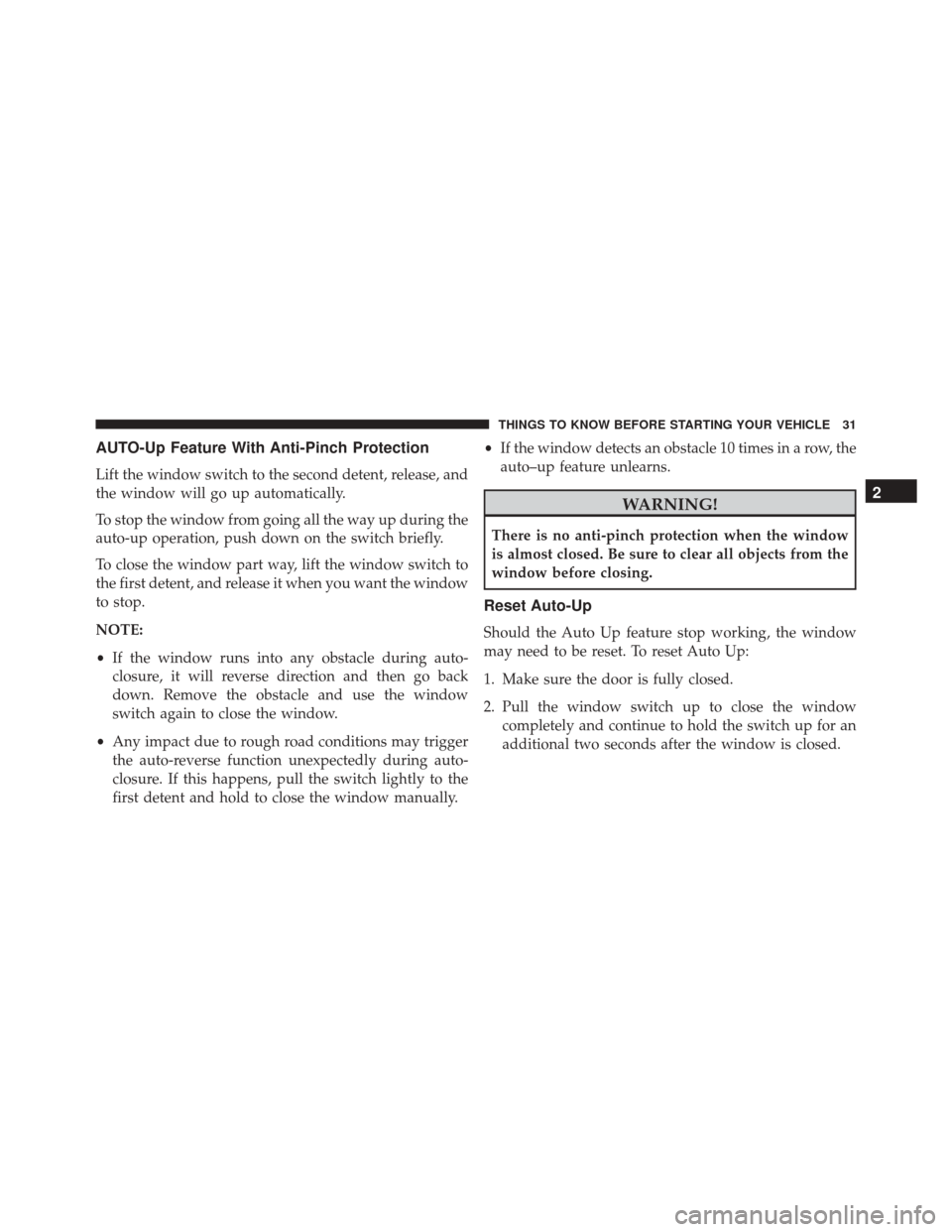
AUTO-Up Feature With Anti-Pinch Protection
Lift the window switch to the second detent, release, and
the window will go up automatically.
To stop the window from going all the way up during the
auto-up operation, push down on the switch briefly.
To close the window part way, lift the window switch to
the first detent, and release it when you want the window
to stop.
NOTE:
•If the window runs into any obstacle during auto-
closure, it will reverse direction and then go back
down. Remove the obstacle and use the window
switch again to close the window.
• Any impact due to rough road conditions may trigger
the auto-reverse function unexpectedly during auto-
closure. If this happens, pull the switch lightly to the
first detent and hold to close the window manually. •
If the window detects an obstacle 10 times in a row, the
auto–up feature unlearns.
WARNING!
There is no anti-pinch protection when the window
is almost closed. Be sure to clear all objects from the
window before closing.
Reset Auto-Up
Should the Auto Up feature stop working, the window
may need to be reset. To reset Auto Up:
1. Make sure the door is fully closed.
2. Pull the window switch up to close the window completely and continue to hold the switch up for an
additional two seconds after the window is closed.
2
THINGS TO KNOW BEFORE STARTING YOUR VEHICLE 31
Page 38 of 427
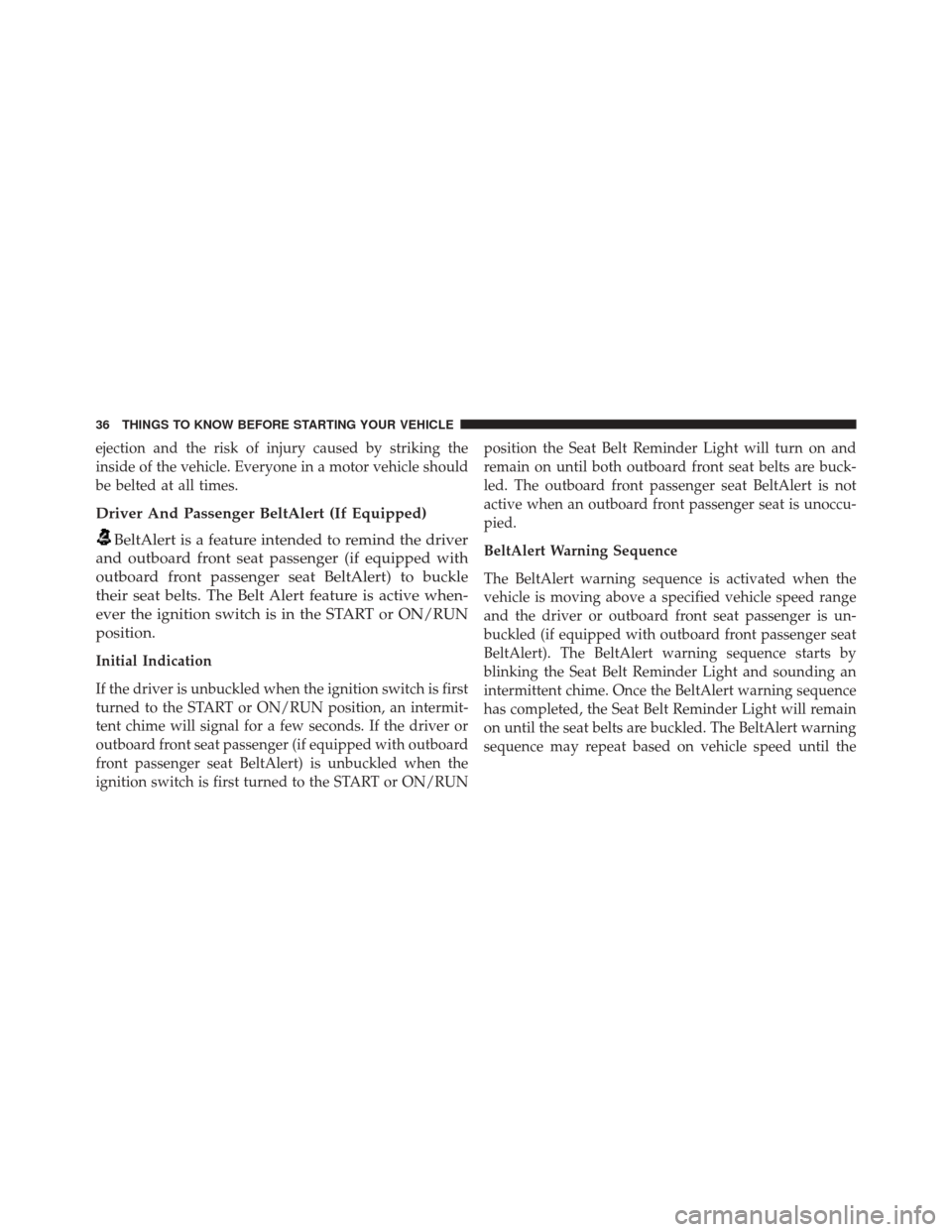
ejection and the risk of injury caused by striking the
inside of the vehicle. Everyone in a motor vehicle should
be belted at all times.
Driver And Passenger BeltAlert (If Equipped)
BeltAlert is a feature intended to remind the driver
and outboard front seat passenger (if equipped with
outboard front passenger seat BeltAlert) to buckle
their seat belts. The Belt Alert feature is active when-
ever the ignition switch is in the START or ON/RUN
position.
Initial Indication
If the driver is unbuckled when the ignition switch is first
turned to the START or ON/RUN position, an intermit-
tent chime will signal for a few seconds. If the driver or
outboard front seat passenger (if equipped with outboard
front passenger seat BeltAlert) is unbuckled when the
ignition switch is first turned to the START or ON/RUN position the Seat Belt Reminder Light will turn on and
remain on until both outboard front seat belts are buck-
led. The outboard front passenger seat BeltAlert is not
active when an outboard front passenger seat is unoccu-
pied.
BeltAlert Warning Sequence
The BeltAlert warning sequence is activated when the
vehicle is moving above a specified vehicle speed range
and the driver or outboard front seat passenger is un-
buckled (if equipped with outboard front passenger seat
BeltAlert). The BeltAlert warning sequence starts by
blinking the Seat Belt Reminder Light and sounding an
intermittent chime. Once the BeltAlert warning sequence
has completed, the Seat Belt Reminder Light will remain
on until the seat belts are buckled. The BeltAlert warning
sequence may repeat based on vehicle speed until the
36 THINGS TO KNOW BEFORE STARTING YOUR VEHICLE
Page 39 of 427
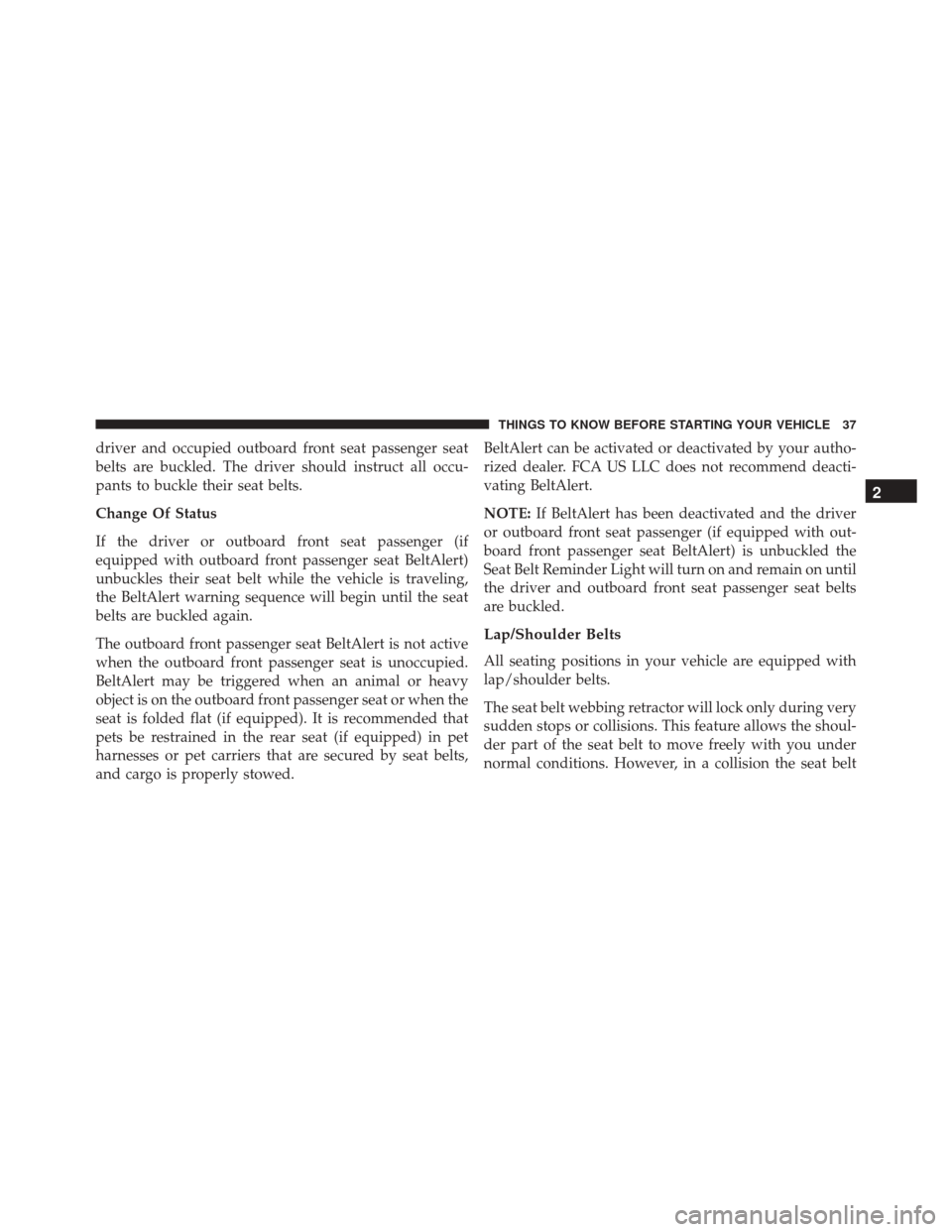
driver and occupied outboard front seat passenger seat
belts are buckled. The driver should instruct all occu-
pants to buckle their seat belts.
Change Of Status
If the driver or outboard front seat passenger (if
equipped with outboard front passenger seat BeltAlert)
unbuckles their seat belt while the vehicle is traveling,
the BeltAlert warning sequence will begin until the seat
belts are buckled again.
The outboard front passenger seat BeltAlert is not active
when the outboard front passenger seat is unoccupied.
BeltAlert may be triggered when an animal or heavy
object is on the outboard front passenger seat or when the
seat is folded flat (if equipped). It is recommended that
pets be restrained in the rear seat (if equipped) in pet
harnesses or pet carriers that are secured by seat belts,
and cargo is properly stowed.BeltAlert can be activated or deactivated by your autho-
rized dealer. FCA US LLC does not recommend deacti-
vating BeltAlert.
NOTE:
If BeltAlert has been deactivated and the driver
or outboard front seat passenger (if equipped with out-
board front passenger seat BeltAlert) is unbuckled the
Seat Belt Reminder Light will turn on and remain on until
the driver and outboard front seat passenger seat belts
are buckled.
Lap/Shoulder Belts
All seating positions in your vehicle are equipped with
lap/shoulder belts.
The seat belt webbing retractor will lock only during very
sudden stops or collisions. This feature allows the shoul-
der part of the seat belt to move freely with you under
normal conditions. However, in a collision the seat belt
2
THINGS TO KNOW BEFORE STARTING YOUR VEHICLE 37
Page 49 of 427
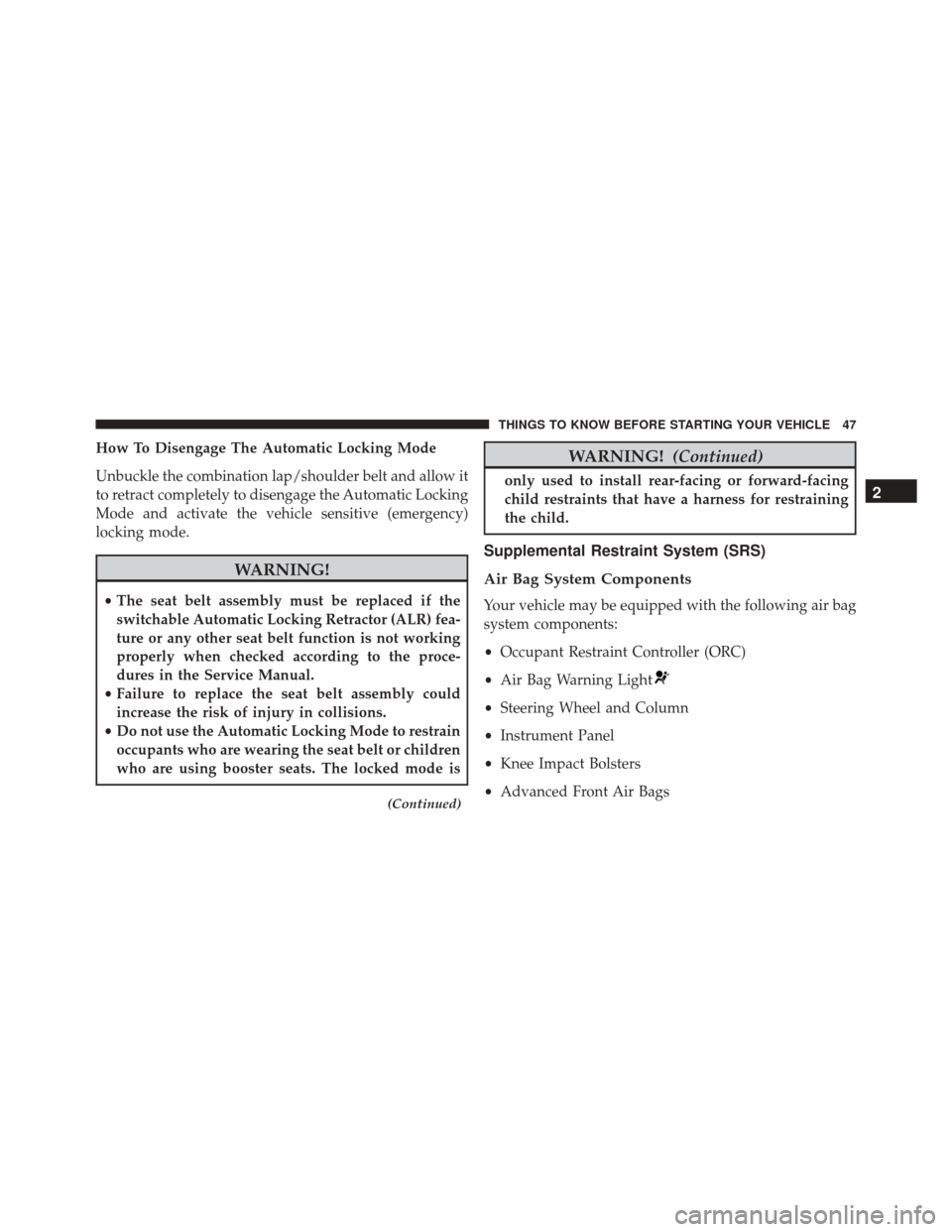
How To Disengage The Automatic Locking Mode
Unbuckle the combination lap/shoulder belt and allow it
to retract completely to disengage the Automatic Locking
Mode and activate the vehicle sensitive (emergency)
locking mode.
WARNING!
•The seat belt assembly must be replaced if the
switchable Automatic Locking Retractor (ALR) fea-
ture or any other seat belt function is not working
properly when checked according to the proce-
dures in the Service Manual.
• Failure to replace the seat belt assembly could
increase the risk of injury in collisions.
• Do not use the Automatic Locking Mode to restrain
occupants who are wearing the seat belt or children
who are using booster seats. The locked mode is
(Continued)
WARNING! (Continued)
only used to install rear-facing or forward-facing
child restraints that have a harness for restraining
the child.
Supplemental Restraint System (SRS)
Air Bag System Components
Your vehicle may be equipped with the following air bag
system components:
•Occupant Restraint Controller (ORC)
• Air Bag Warning Light
•Steering Wheel and Column
• Instrument Panel
• Knee Impact Bolsters
• Advanced Front Air Bags
2
THINGS TO KNOW BEFORE STARTING YOUR VEHICLE 47
Page 52 of 427
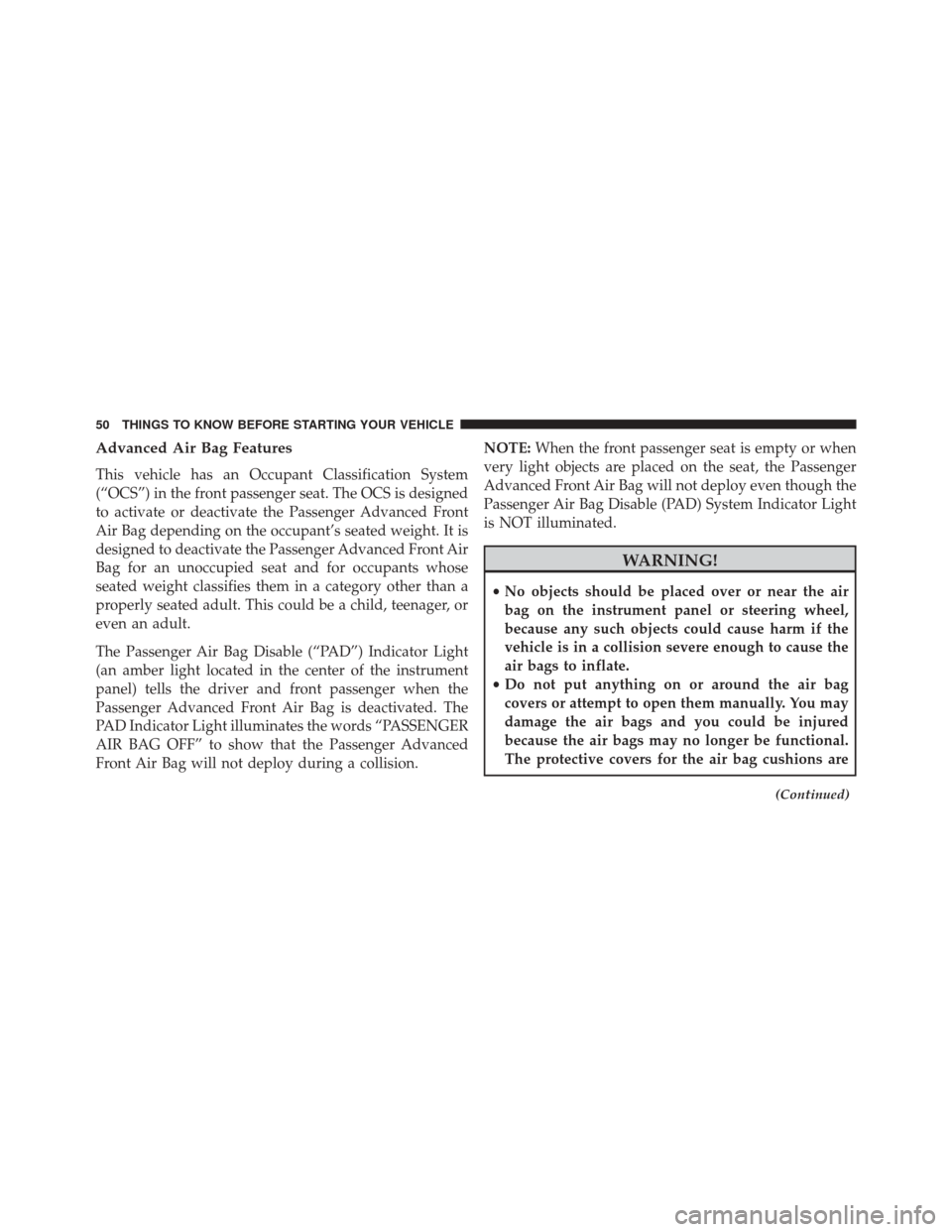
Advanced Air Bag Features
This vehicle has an Occupant Classification System
(“OCS”) in the front passenger seat. The OCS is designed
to activate or deactivate the Passenger Advanced Front
Air Bag depending on the occupant’s seated weight. It is
designed to deactivate the Passenger Advanced Front Air
Bag for an unoccupied seat and for occupants whose
seated weight classifies them in a category other than a
properly seated adult. This could be a child, teenager, or
even an adult.
The Passenger Air Bag Disable (“PAD”) Indicator Light
(an amber light located in the center of the instrument
panel) tells the driver and front passenger when the
Passenger Advanced Front Air Bag is deactivated. The
PAD Indicator Light illuminates the words “PASSENGER
AIR BAG OFF” to show that the Passenger Advanced
Front Air Bag will not deploy during a collision.NOTE:
When the front passenger seat is empty or when
very light objects are placed on the seat, the Passenger
Advanced Front Air Bag will not deploy even though the
Passenger Air Bag Disable (PAD) System Indicator Light
is NOT illuminated.
WARNING!
• No objects should be placed over or near the air
bag on the instrument panel or steering wheel,
because any such objects could cause harm if the
vehicle is in a collision severe enough to cause the
air bags to inflate.
• Do not put anything on or around the air bag
covers or attempt to open them manually. You may
damage the air bags and you could be injured
because the air bags may no longer be functional.
The protective covers for the air bag cushions are
(Continued)
50 THINGS TO KNOW BEFORE STARTING YOUR VEHICLE
Page 55 of 427
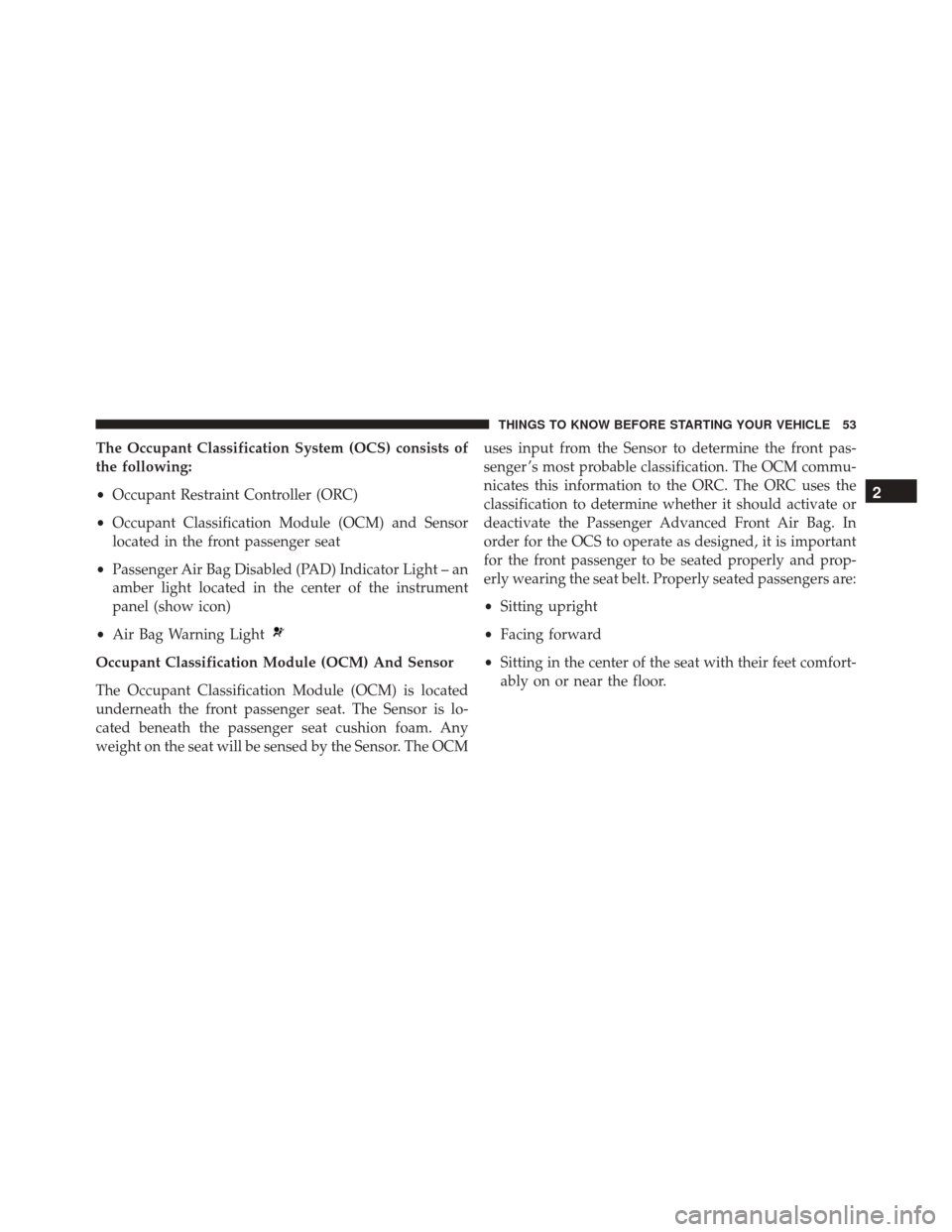
The Occupant Classification System (OCS) consists of
the following:
•Occupant Restraint Controller (ORC)
• Occupant Classification Module (OCM) and Sensor
located in the front passenger seat
• Passenger Air Bag Disabled (PAD) Indicator Light – an
amber light located in the center of the instrument
panel (show icon)
• Air Bag Warning Light
Occupant Classification Module (OCM) And Sensor
The Occupant Classification Module (OCM) is located
underneath the front passenger seat. The Sensor is lo-
cated beneath the passenger seat cushion foam. Any
weight on the seat will be sensed by the Sensor. The OCM uses input from the Sensor to determine the front pas-
senger ’s most probable classification. The OCM commu-
nicates this information to the ORC. The ORC uses the
classification to determine whether it should activate or
deactivate the Passenger Advanced Front Air Bag. In
order for the OCS to operate as designed, it is important
for the front passenger to be seated properly and prop-
erly wearing the seat belt. Properly seated passengers are:
•
Sitting upright
• Facing forward
• Sitting in the center of the seat with their feet comfort-
ably on or near the floor.
2
THINGS TO KNOW BEFORE STARTING YOUR VEHICLE 53
Page 58 of 427
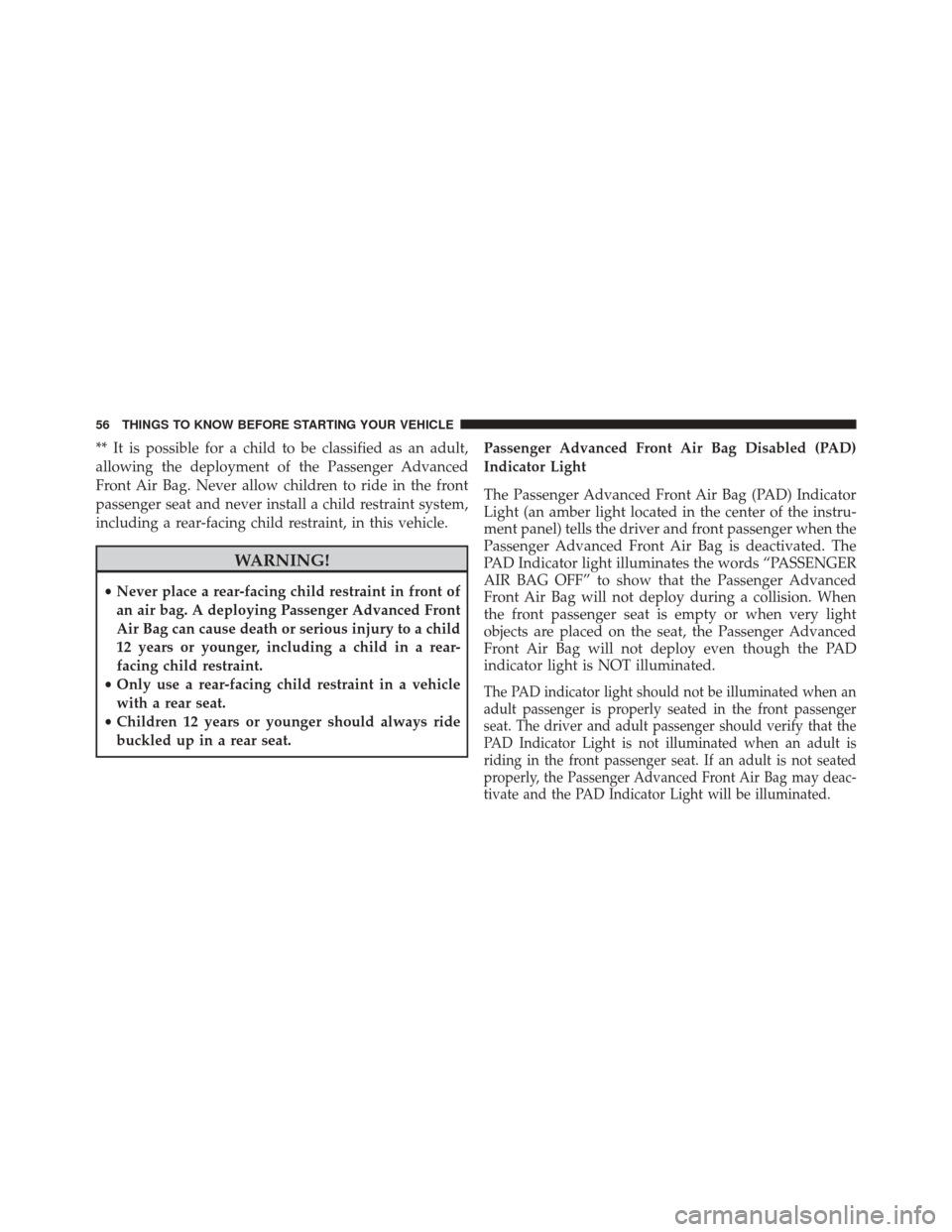
** It is possible for a child to be classified as an adult,
allowing the deployment of the Passenger Advanced
Front Air Bag. Never allow children to ride in the front
passenger seat and never install a child restraint system,
including a rear-facing child restraint, in this vehicle.
WARNING!
•Never place a rear-facing child restraint in front of
an air bag. A deploying Passenger Advanced Front
Air Bag can cause death or serious injury to a child
12 years or younger, including a child in a rear-
facing child restraint.
• Only use a rear-facing child restraint in a vehicle
with a rear seat.
• Children 12 years or younger should always ride
buckled up in a rear seat. Passenger Advanced Front Air Bag Disabled (PAD)
Indicator Light
The Passenger Advanced Front Air Bag (PAD) Indicator
Light (an amber light located in the center of the instru-
ment panel) tells the driver and front passenger when the
Passenger Advanced Front Air Bag is deactivated. The
PAD Indicator light illuminates the words “PASSENGER
AIR BAG OFF” to show that the Passenger Advanced
Front Air Bag will not deploy during a collision. When
the front passenger seat is empty or when very light
objects are placed on the seat, the Passenger Advanced
Front Air Bag will not deploy even though the PAD
indicator light is NOT illuminated.
The PAD indicator light should not be illuminated when an
adult passenger is properly seated in the front passenger
seat. The driver and adult passenger should verify that the
PAD Indicator Light is not illuminated when an adult is
riding in the front passenger seat. If an adult is not seated
properly, the Passenger Advanced Front Air Bag may deac-
tivate and the PAD Indicator Light will be illuminated.
56 THINGS TO KNOW BEFORE STARTING YOUR VEHICLE
Page 60 of 427
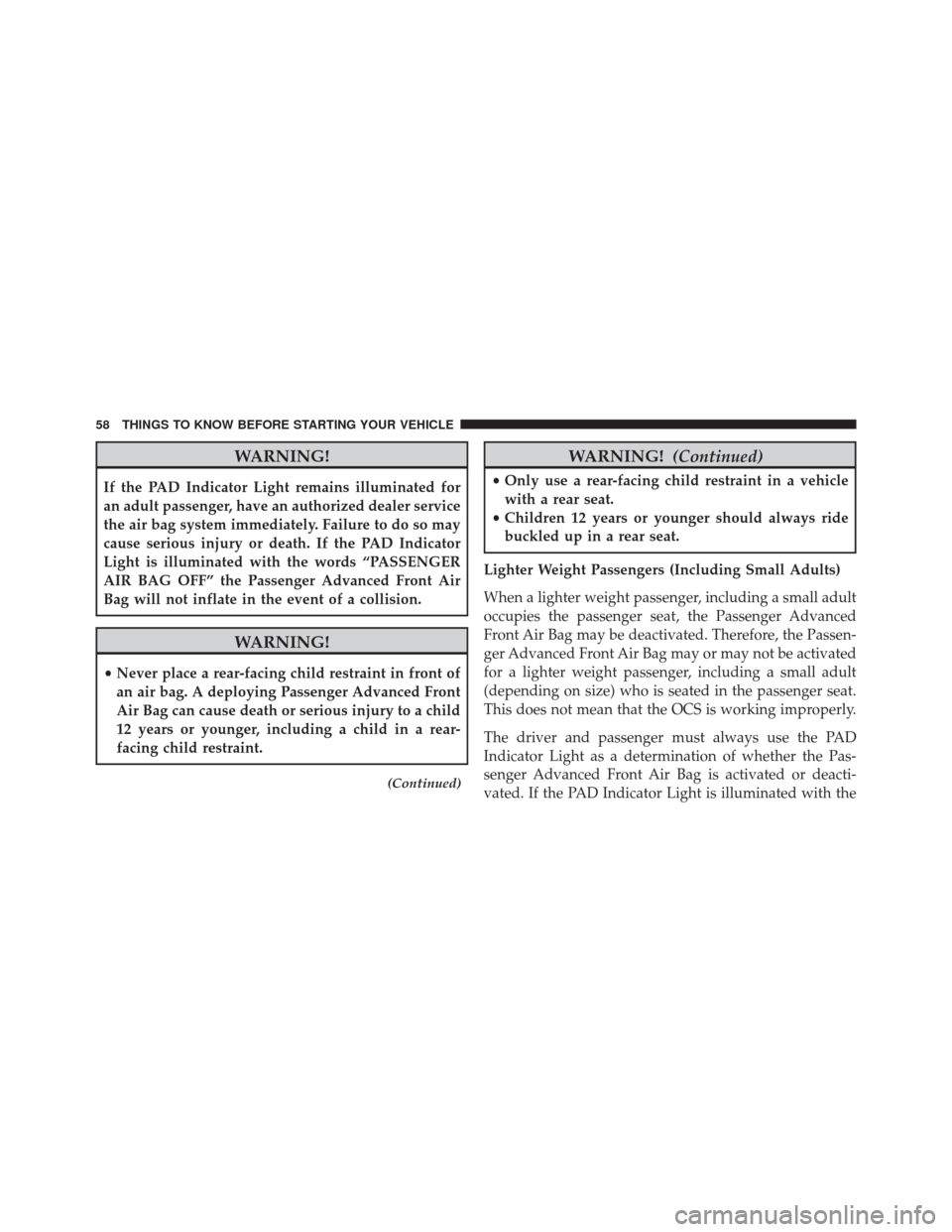
WARNING!
If the PAD Indicator Light remains illuminated for
an adult passenger, have an authorized dealer service
the air bag system immediately. Failure to do so may
cause serious injury or death. If the PAD Indicator
Light is illuminated with the words “PASSENGER
AIR BAG OFF” the Passenger Advanced Front Air
Bag will not inflate in the event of a collision.
WARNING!
•Never place a rear-facing child restraint in front of
an air bag. A deploying Passenger Advanced Front
Air Bag can cause death or serious injury to a child
12 years or younger, including a child in a rear-
facing child restraint.
(Continued)
WARNING! (Continued)
•Only use a rear-facing child restraint in a vehicle
with a rear seat.
• Children 12 years or younger should always ride
buckled up in a rear seat.
Lighter Weight Passengers (Including Small Adults)
When a lighter weight passenger, including a small adult
occupies the passenger seat, the Passenger Advanced
Front Air Bag may be deactivated. Therefore, the Passen-
ger Advanced Front Air Bag may or may not be activated
for a lighter weight passenger, including a small adult
(depending on size) who is seated in the passenger seat.
This does not mean that the OCS is working improperly.
The driver and passenger must always use the PAD
Indicator Light as a determination of whether the Pas-
senger Advanced Front Air Bag is activated or deacti-
vated. If the PAD Indicator Light is illuminated with the
58 THINGS TO KNOW BEFORE STARTING YOUR VEHICLE
Page 64 of 427
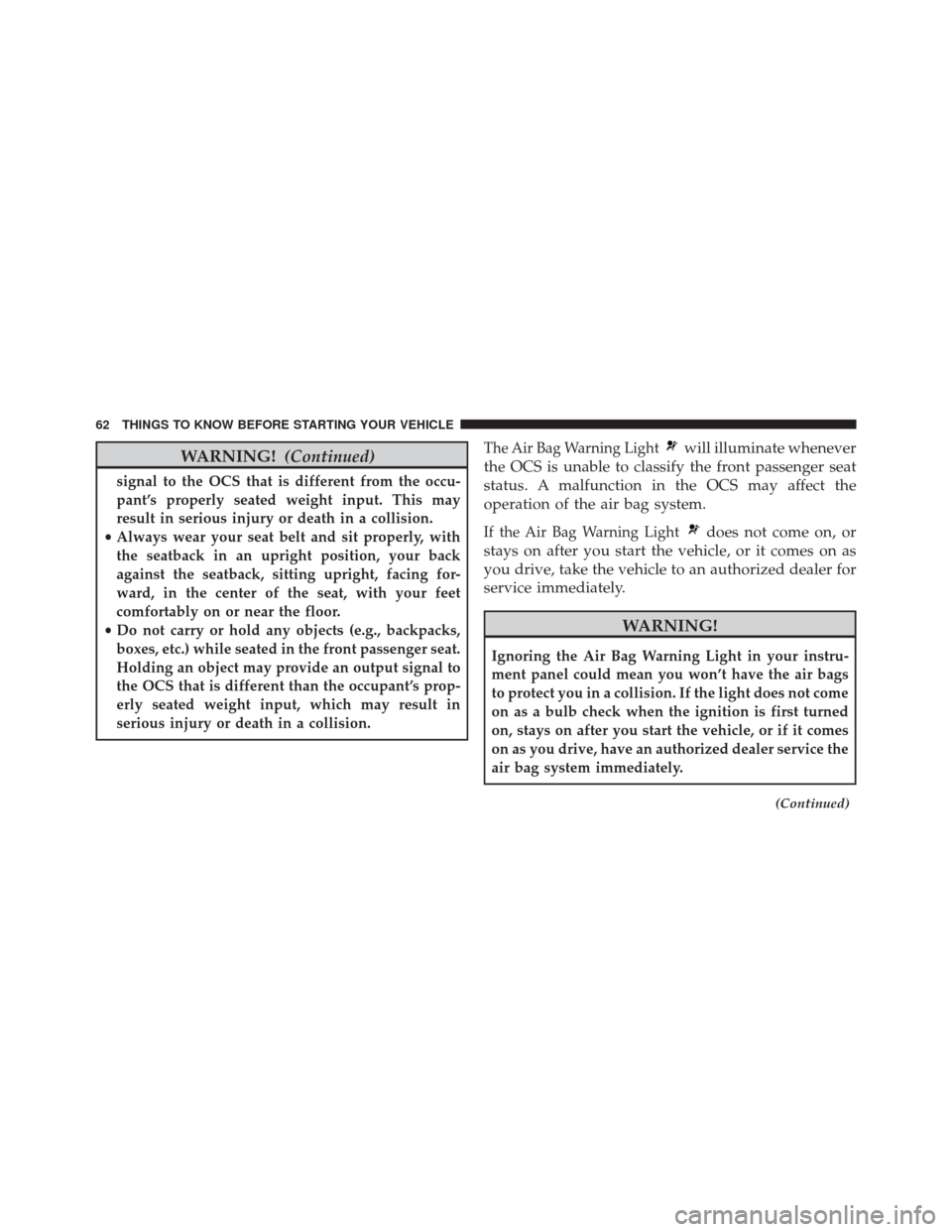
WARNING!(Continued)
signal to the OCS that is different from the occu-
pant’s properly seated weight input. This may
result in serious injury or death in a collision.
• Always wear your seat belt and sit properly, with
the seatback in an upright position, your back
against the seatback, sitting upright, facing for-
ward, in the center of the seat, with your feet
comfortably on or near the floor.
• Do not carry or hold any objects (e.g., backpacks,
boxes, etc.) while seated in the front passenger seat.
Holding an object may provide an output signal to
the OCS that is different than the occupant’s prop-
erly seated weight input, which may result in
serious injury or death in a collision. The Air Bag Warning Light
will illuminate whenever
the OCS is unable to classify the front passenger seat
status. A malfunction in the OCS may affect the
operation of the air bag system.
If the Air Bag Warning Lightdoes not come on, or
stays on after you start the vehicle, or it comes on as
you drive, take the vehicle to an authorized dealer for
service immediately.
WARNING!
Ignoring the Air Bag Warning Light in your instru-
ment panel could mean you won’t have the air bags
to protect you in a collision. If the light does not come
on as a bulb check when the ignition is first turned
on, stays on after you start the vehicle, or if it comes
on as you drive, have an authorized dealer service the
air bag system immediately.
(Continued)
62 THINGS TO KNOW BEFORE STARTING YOUR VEHICLE
Page 65 of 427
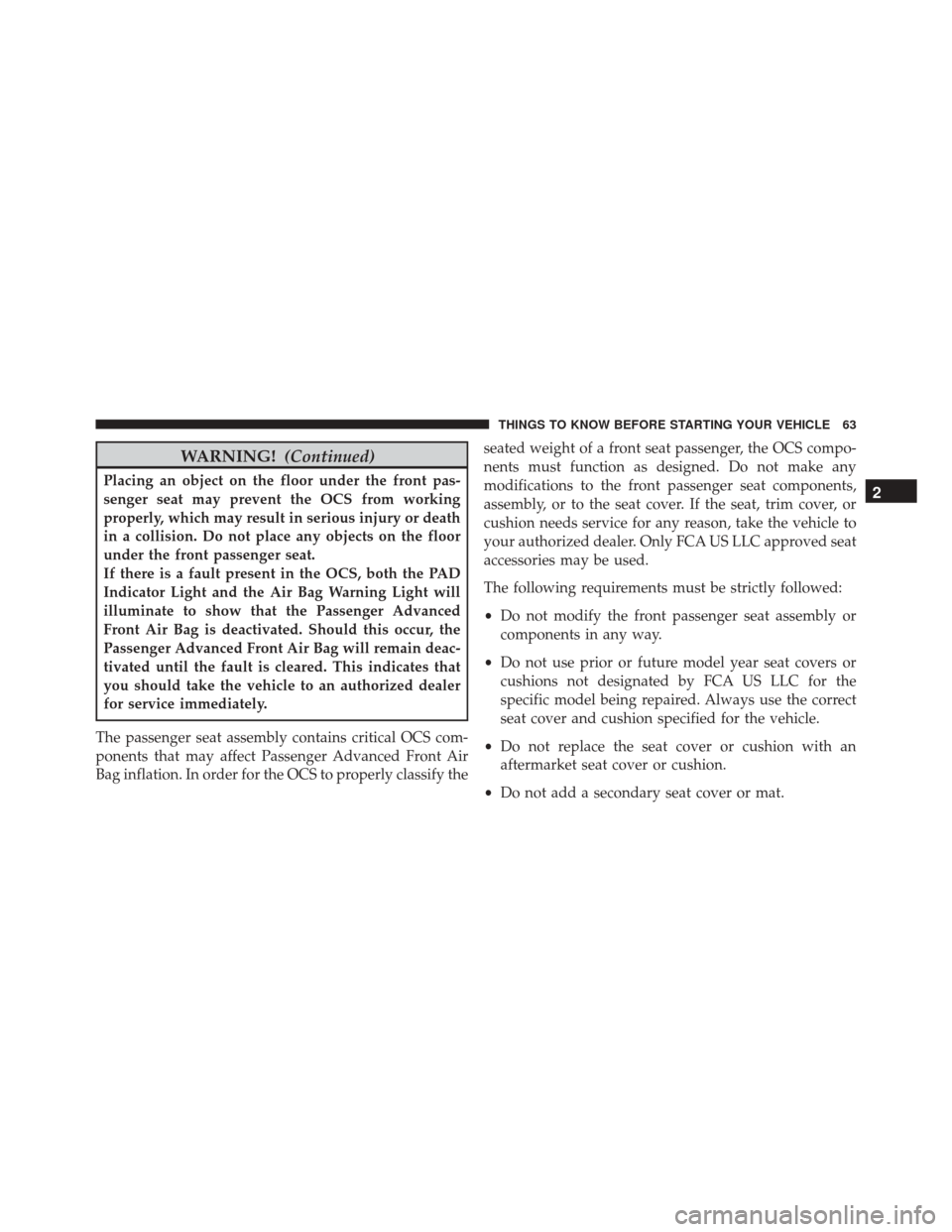
WARNING!(Continued)
Placing an object on the floor under the front pas-
senger seat may prevent the OCS from working
properly, which may result in serious injury or death
in a collision. Do not place any objects on the floor
under the front passenger seat.
If there is a fault present in the OCS, both the PAD
Indicator Light and the Air Bag Warning Light will
illuminate to show that the Passenger Advanced
Front Air Bag is deactivated. Should this occur, the
Passenger Advanced Front Air Bag will remain deac-
tivated until the fault is cleared. This indicates that
you should take the vehicle to an authorized dealer
for service immediately.
The passenger seat assembly contains critical OCS com-
ponents that may affect Passenger Advanced Front Air
Bag inflation. In order for the OCS to properly classify the seated weight of a front seat passenger, the OCS compo-
nents must function as designed. Do not make any
modifications to the front passenger seat components,
assembly, or to the seat cover. If the seat, trim cover, or
cushion needs service for any reason, take the vehicle to
your authorized dealer. Only FCA US LLC approved seat
accessories may be used.
The following requirements must be strictly followed:
•
Do not modify the front passenger seat assembly or
components in any way.
• Do not use prior or future model year seat covers or
cushions not designated by FCA US LLC for the
specific model being repaired. Always use the correct
seat cover and cushion specified for the vehicle.
• Do not replace the seat cover or cushion with an
aftermarket seat cover or cushion.
• Do not add a secondary seat cover or mat.2
THINGS TO KNOW BEFORE STARTING YOUR VEHICLE 63